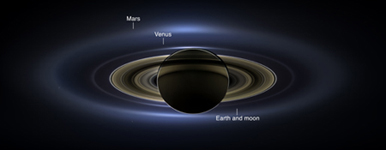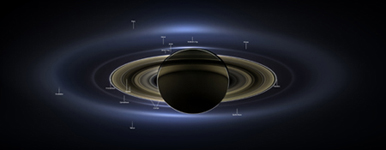In our quest to discover strange new life on strange new worlds, a group of astronomers has modeled potential alien worlds using Earth’s biological history as a framework. From this they have determined that if we are to detect extraterrestrial biology, we should fine-tune our search to the color purple.
As we discover more and more worlds orbiting other stars in ever more biologically-pleasing orbits, the question “are we alone?” becomes increasingly acute. It’s inevitable that we will soon discover an alien world with Earth-like dimensions, orbiting a sun-like star within its habitable zone. But until we develop the means to remotely probe that world’s atmosphere, we can never be sure if it is truly habitable.
Looking for a “true” Earth analog is fraught with challenges. Are we looking for a planet with the same characteristics as modern Earth, or do we try to model our planets during different epochs and work out when Earth life would have been at its most detectable? Life on Earth has been around for the best part of 4 billion years, when would have been best for an alien civilization to detect terrestrial life and what would they have needed to look for?
It’s exactly this question that an international team of researchers is trying to answer.
“Clearly what we know about our planet will be our guideline for the characterization of (small rocky worlds in the habitable zones of their stars),” writes the team, headed by Esther Sanroma of the Instituto de Astrofísica de Canarias (IAC), Spain, in a paper accepted for publication in the Astrophysical Journal. “But the Earth has been inhabited for at least 3.8 (billion years), and its appearance has changed with time.”
3 billion years ago, during the Archean eon, the Earth was likely dominated by purple bacteria, a photosynthetic microorganism that inhabited the land and ancient seas. These organisms would have had a very distinctive spectroscopic fingerprint and a tell-tail sign that Earth was covered in a basic form of life.
By modeling different distributions of this microbe throughout the planet — in the oceans, on the land, around coastlines and during different atmospheric conditions — Sanroma’s team used a radiative transfer model “to simulate the visible and near-(infrared) radiation reflected by our planet.” By doing so, they were able to determine that by using multi-color photometric observations, distant observers would be able to “distinguish between an Archean Earth in which purple bacteria inhabit vast extensions of the planet, and a present-day Earth with continents covered by deserts, vegetation or microbial mats.”
When looking for Earth-like worlds, the researchers emphasize the need for exoplanet hunters to be aware that they may not discover a modern-looking Earth-like world, they may stumble across a purple bacteria-dominated world with a very distinctive photometric signature more fitting with an ancient Archean eon Earth-like world.
“Earth is the only planet where life is known to exist; thus observations of our planet will be a key instrument for characterization and the search for life elsewhere. However, even if we discovered a second Earth, it is very unlikely that it would present a stage of evolution similar to the present-day Earth.”

Purple plants may thrive under binary stars.
UNIVERSITY OF ST. ANDREWS
This isn’t the first time that purple alien worlds have been discussed as a possibility. In 2011, researchers examined the exotic energy-generating regimes hypothetical alien plant life would need to develop under sunlight from binary stars.
Over 25 percent of sun-like stars and 50 percent of red dwarf stars exist in binary pairs. Should there be any planets in orbit around binary systems, any life — be it flora or fauna, or some alien form of life that we can’t comprehend, let alone categorize — would be exposed to a broad spectra of light, stretching far into ultraviolet wavelengths. The upshot of this would be purple hued (or even black) plant life that has evolved to optimize photosynthesis.
It seems that in the hunt for extraterrestrial life, all roads lead to purple.
Publication: Characterizing the purple Earth: Modelling the globally-integrated spectral variability of the Archean Earth, E. Sanromá, E. Pallé, M. N. Parenteau, N. Y. Kiang, A. M. Gutiérrez-Navarro, R. López, P. Montañés-Rodríguez, 2013. arXiv:1311.1145 [astro-ph.EP]
Image credit: NASA (purple added)



